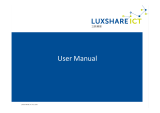
Shooting and Playback
17
En_01
Step 4 Focus and shoot
4.1 Press the shutter-release
button halfway.
• When the subject is in focus,
the focus area that includes the
subject or focus indicator
glows green (multiple focus
areas can glow green).
• Wh
en you are using digital
z
oom, the camera focuses on
the subject in the center of the
frame and the focus area is not
displayed. When the camera
has focused, the focus indicator
glows green.
• I
f the focus area or focus
i
ndicator flashes red, the camera is unable to focus. Modify the
composition and try pressing the shutter-release button halfway
again.
4.2 Without lifting your finger, press the shutter-release button the
rest of the way down.
Flash Status Display
When you press the shutter-release button
halfway, you can check the flash status by the
flash mode icon at the top of the monitor.
• On: The flash fires in accordance with the flash
m
ode when you press the shutter-release
button all the way down. When U (auto) is
set, the flash fires when W is displayed.
• Flashing: The flash is charging. The camera cannot shoot images.
• Off: The flash does not fire when an image is taken.
1/2501/2501/250 F5.6F5.6F5.6





















